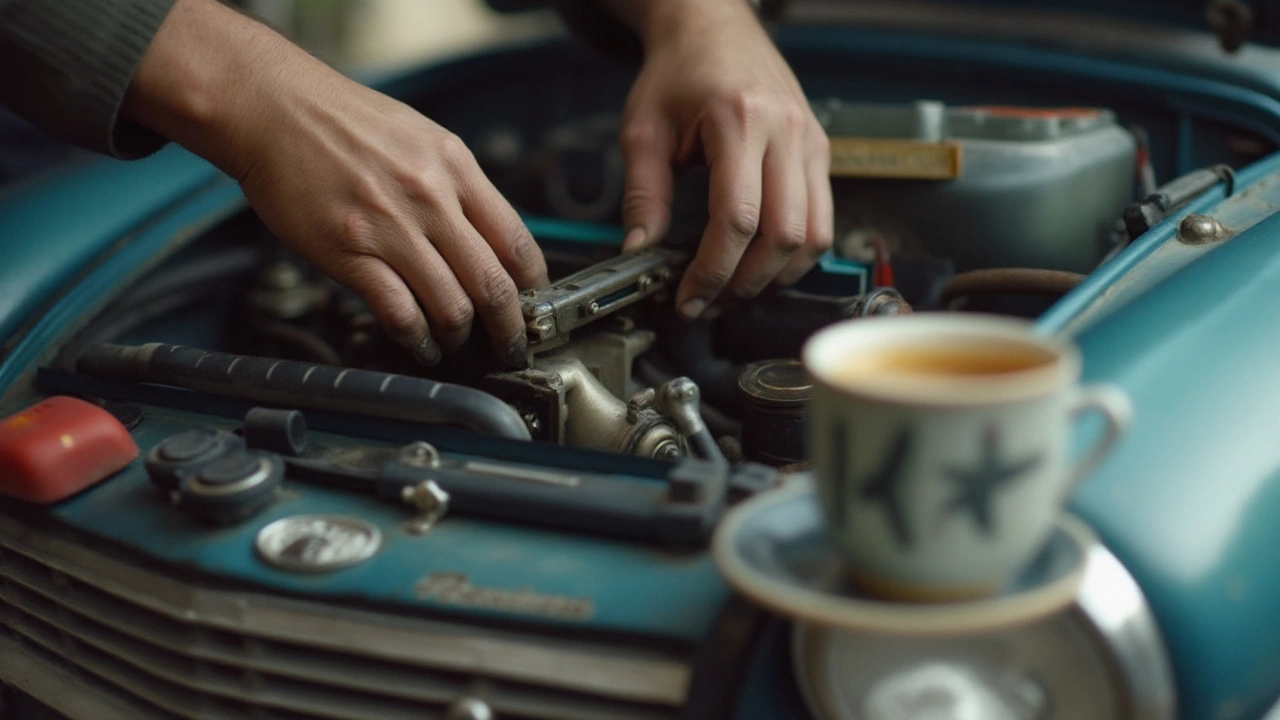Tackling a failing fuel pump might feel overwhelming, especially when you're miles away from a mechanic. Thankfully, there are some handy tricks that can temporarily get your car running again. A fuel pump is a vital component, handling the delivery of fuel from the tank to the engine. When it starts acting up, your vehicle can lose power or refuse to start altogether.
Before diving into quick fixes, it's critical to verify that the fuel pump is the true culprit. Common symptoms often include the engine stuttering, a sudden loss of power, or unusual noises from the fuel tank area. Once you're certain, knowing the right temporary methods can save the day until a professional repair can be scheduled. Roll up your sleeves, as we guide you through these techniques, ensuring a smoother ride when unpredictability strikes.
- Understanding the Fuel Pump Function
- Signs of a Failing Fuel Pump
- Safety Precautions Before Attempting Repairs
- Tools and Materials Needed for a Temporary Fix
- Step-by-Step Temporary Fix Techniques
- When to Seek Professional Help
Understanding the Fuel Pump Function
The fuel pump might be considered one of the unsung heroes nestled deep within your vehicle's mechanics. Its core responsibility is deceptively simple, yet absolutely crucial. This small but mighty component acts as the beating heart of your car’s fuel system, pumping gasoline or diesel from the tank to the engine where it can be ignited to power the vehicle. Without this steady flow of fuel, even the most powerful engine would come to a standstill. It's important to note that modern cars typically use two types of fuel pumps: mechanical pumps and electric pumps. Mechanical types are often found in older vehicles, whereas electric pumps have become standard due to their efficiency and reliability.
The mechanics of a fuel pump are intriguing. When the fuel pump is activated, it creates pressure that pushes the fuel from the tank, through the fuel lines, and into the engine. This action not only requires precise engineering but also durable materials that can handle the wear and tear of constant use. The pump must maintain a precise pressure to ensure that the right amount of fuel is mixed with air in the carburetor or fuel injectors—too little, and the engine can stall; too much, and you risk flooding it. It’s a delicate balance that the fuel pump manages continuously.
Let’s delve into a more technical aspect: the construction and inner workings. The typical electric fuel pump consists of several components, including the pump itself, a pressure regulator, and a filter or screen to catch impurities. Most pumps are located in the fuel tank, submerged in the very liquid they’re designed to move. This strategic placement not only cools the pump but also minimizes the risk of vapor lock—a troublesome phenomenon where fuel vaporizes in the fuel lines, disrupting the pump’s ability to send liquid fuel to the engine.
According to automotive expert Richard Langworth, "The reliability of a car's fuel pump is paramount, considering it powers our everyday journeys as much as the engine does."
A healthy fuel pump can last for well over 100,000 miles, though it’s not uncommon to see pumps needing replacement after about 50,000 miles, especially under heavy vehicle use or harsh conditions.
To wrap it up, it’s important to recognize that a failing fuel pump can mimic other issues like clogged fuel filters or malfunctioning injectors. Because of this, accurate diagnosis is crucial. Keep an ear out for whining noises emanating from the fuel tank or observe for engine misfires during acceleration, which could indicate a struggling fuel pump. Understanding how a fuel pump operates not only fosters a deeper appreciation for the engineering marvels that propel us forward but also equips you with the knowledge to pinpoint problems before they leave you stranded.
| Fuel Pump Type | Common Vehicle Use | Expected Lifespan |
|---|---|---|
| Mechanical | Older Vehicles | 50,000 to 80,000 miles |
| Electric | Modern Vehicles | 100,000+ miles |
Signs of a Failing Fuel Pump
When it comes to car maintenance, knowing the signals that your fuel pump is on the fritz can save both your time and wallet a good deal of stress. A failing fuel pump doesn't just leave you stranded, it can also have ripple effects on other parts of your vehicle, making early detection crucial. One common sign is the engine sputtering at high speeds. This occurs because the pump is failing to provide the engine with the steady flow of fuel it needs for smooth operation. Another telltale sign is a sudden loss of power during acceleration, indicating the fuel pump can't keep up with demand. Drivers may also notice a decrease in fuel efficiency, as a faulty pump can throw off the delicate fuel-to-air ratio, causing the engine to burn excess fuel.
Keep an ear out for whining noises emanating from the fuel tank—unusual sounds like these are often one of the clearest red flags. Pay attention at startup; a longer cranking time or needing multiple attempts could mean the pump's not building enough pressure for the engine to fire up properly. Inconsistent engine performance, where the car struggles in certain conditions but not others, is another clue. This inconsistency can make diagnosing the issue tricky since it often mimics other potential problems. As the engine starves for fuel, it may also trigger the check engine light, though this could lead you on a wild goose chase if misdiagnosed.
High temperatures can exacerbate pump problems, causing your car to stall unexpectedly. This scenario is particularly hazardous as it can happen while driving, leading you to pull over without warning. One seasoned mechanic once noted,
"A bad fuel pump can leave you stuck faster than you think, particularly on long trips where heat and sustained speed put extra strain on the system."Finally, complete engine failure may occur, meaning the pump can't deliver any fuel at all, leaving the vehicle undrivable. Once these signs are recognized, timely intervention is your best ally to prevent more grave repair tasks down the line.

Safety Precautions Before Attempting Repairs
Before diving headfirst into your car's fuel pump repair, it's crucial to put safety at the forefront. Working on vehicles can be risky business, especially when dealing with components like the fuel system that involve combustible materials. The first step is to ensure your vehicle is parked on a flat, stable surface. Engaging the parking brake can prevent unexpected movements, significantly reducing the risk of accidents. Equally, wearing safety goggles and gloves is not just an option but a necessity to protect your eyes and skin from harmful substances and sharp edges.
It's also wise to disconnect the battery before you begin any repairs. Doing so minimizes the chances of electric shocks, and it can prevent accidental airbag deployment. Battery terminals can sometimes discharge unexpectedly, so use insulated tools if possible. While you're at it, make sure the area you're working in is well-ventilated. Fumes from fuels and chemicals can be harmful if inhaled, causing dizziness or breathing issues. Keeping a fire extinguisher nearby as a precaution never hurts; it's better to be overprepared than underprepared.
Remember, if you're feeling uncertain at any step, there's no shame in pausing and reassessing. According to automotive safety expert Tom Magliozzi, "The best mechanic is a safe mechanic." Ensuring you follow the proper guidance doesn't just apply to professionals but to DIY enthusiasts as well. It's also recommended to have the vehicle's manual handy; it offers valuable information that's specific to your model, including safe handling and repair techniques.
An organized workspace can also play a vital role. Keep your tools arranged and parts laid out in a manner that makes sense to you. This not only saves time but reduces any potential injuries from scrambling around. Avoid loose clothing and keep long hair tied back—anything that could snag on parts or get caught in moving mechanisms. Finally, staying hydrated is a simple but often overlooked tip, as dehydration can affect your attention and decision-making skills.
By taking these precautions to heart, you prepare yourself for a more efficient and safer attempt at a temporary fix. It's as much about mindset as it is about method, and understanding the complexities of a vehicle just enhances the process. Being aware of these steps keeps both you and your car in better shape, proving that preventive measures are as essential as the repair itself. So make safety your priority, and you can tackle the task with confidence.
Tools and Materials Needed for a Temporary Fix
When the unexpected hits and your fuel pump starts to falter, having the right tools and materials on hand can make all the difference. Think of it as a first-aid kit for your car, ready to patch up the issue until you can head to a professional for a permanent solution. First things first, a basic understanding of what you'll need and how to use these items safely will set you up for success. While the rigors of the road may vary, some faithful companions should always ride along in your toolbox.
Key among the tools is a multimeter, essential for diagnosing electrical issues. With this handy device, you can check if electrical current is reaching the pump, an often-overlooked step in troubleshooting. Next, a set of screwdrivers and pliers will be needed to maneuver clamps and cover plates — these basic tools are indispensable in nearly any car-related scenario. It’s also prudent to have a hand vacuum pump, which can re-prime the system by drawing fuel through manually, potentially allaying more involved complications.
On the material side, having some wire connectors and electrical tape could prove beneficial. These items help cover up or secure any loose connections, another common cause of pump failure. A length of fuel hose is advisable too; you might need it to replace cracked or leaking segments that hinder fuel delivery. Even carrying a fuel pump relay is a good idea, as swapping it out can sometimes rectify the issue without further ado. Many drivers have shared their own stories, swearing by swapping a spare relay as a miraculous cure-all.
As noted by Jane Dawson, an automotive enthusiast and author, "Preparedness is not about predicting every issue, but rather equipping yourself with the basics to tackle unforeseen challenges."
Alongside these tools and materials, incorporating a flashlight in your arsenal is wise, especially if you find yourself tinkering after dark or in a dimly lit garage. A couple of clean rags or cloths can help keep things tidy by wiping away fuel residue that may accumulate amid your repairs. Not to mention a portable battery pack or jump starter, which serves dual purposes; both as a source of extra light and means to verify the battery isn't a contributing factor to the fuel pump's woes. Here's a gentle reminder: while temporary fixes might get you back on track, they're no substitute for professional inspection. Your quick fix should be precisely that — quick and temporary.
Utilizing these tools and materials efficiently not only provides a lifeline during unexpected breakdowns but also boosts confidence as you engage with your car's fuel system. There's a certain satisfaction in handling minor issues, knowing you're armed with knowledge and the right tools. Always prioritize safety, venturing slowly and methodically through repairs. At the end of the day, these efforts are about maintaining your car's performance, while getting you back on the road safely and swiftly.

Step-by-Step Temporary Fix Techniques
Getting stranded with a stalling car due to a faulty fuel pump can be quite the dilemma for any driver. Thankfully, several temporary solutions can serve as a lifeline until you can reach a repair shop. Bear in mind, these are short-term fixes and should not substitute for professional care. The importance of understanding your vehicle and its fuel system cannot be overstated. Now, let’s delve into some practical techniques that will get you back on the road.
Pound on the Fuel Tank
One of the simplest temporary fixes involves something called the 'tap-a-tank' method. If your car refuses to start because of a failing fuel pump, gently pounding on the fuel tank with a blunt object can sometimes help. This is by no means a permanent solution, but by creating vibrations inside the tank, it may temporarily adjust the pump's worn-out components to function just enough to turn over the engine. Always do this with caution and avoid excessive force to prevent any structural damage.
Check and Clean Electrical Connections
Another achievable fix is to ensure that all electrical connections associated with the fuel pump are clean and secure. Start by checking the pump’s fuse in the fuse box and replace it if necessary. Corrosion and dirt can accumulate over time on electrical connections, obstructing the flow of electricity vital for pump operation. Clean these connectors with a suitable electrical contact cleaner, making sure all wires are intact. A reliable connection can sometimes revive a faltering pump, even if only temporarily. This procedure is straightforward and doesn’t require much more than elbow grease and a little patience.
According to seasoned mechanics, "A clean electrical connection can ensure a reliable power supply to the fuel pump, preventing unexpected stalling on the road."
Utilize Fuel System Additives
You might be surprised to know that certain fuel additives can provide a reprieve from a dysfunctional fuel pump’s woes. These additives work by cleaning and lubricating the pump’s parts, reducing friction, and often aiding in reviving its performance temporarily. Pour the recommended quantity as per the product’s instructions into the fuel tank, and allow it to circulate and work its magic. While this might give you a bit of breathing room, always remember it doesn't replace the need for a proper mechanical diagnostics and repair.
| Tool | Purpose |
|---|---|
| Blunt object | Tap the fuel tank |
| Electrical contact cleaner | Clean connections |
| Fuel additive | Enhance pump performance |
These temporary solutions provide a cushion when the unexpected occurs, ensuring you have some control in an otherwise unpleasant situation. They each serve their purpose but must be followed with appropriate and timely mechanical attention to keep your journey smooth and steadfast. Sometimes, a proactive approach to highway troubles can turn a potential travel disaster into just another minor bump in the road.
When to Seek Professional Help
While temporary fixes can be a lifesaver when a fuel pump repair is needed but not immediately possible, there comes a time when calling in the experts becomes essential. Recognizing these moments is not just a matter of convenience but crucial for ensuring the longevity of your vehicle and, most importantly, for keeping you and other road users safe. Attempting to drive on a continuously failing fuel pump can lead to complete breakdowns, turning a minor issue into a major problem. If a temporary fix doesn’t alleviate symptoms, or if the problem reappears shortly after patching it up, this is your first red flag. The vehicle might struggle to accelerate smoothly, or the engine may misfire, both clear indicators of the fuel pump delivering erratic fuel pressure.
Another time to wave the white flag and call in the pros is when diagnostic tools indicate low fuel pressure beyond home-fix ability. Modern cars with their complex fuel management systems rely on steady and consistent fuel flow. Driving with inaccurate fuel delivery could harm engine components such as the fuel injectors or catalytic converter, leading to costly repairs. Additionally, if you notice strange smells, usually a strong gasoline odor, it might mean a leak or a dangerous buildup of fuel fumes within your vehicle, making it unsafe to continue driving without professional inspection. An experienced mechanic can conduct pressure tests and fuel system inspections, often using advanced diagnostic equipment that isn’t available for everyday hobbyists or in a standard toolkit.
"When you start facing persistent issues with the fuel pump, it’s essential to bring your car to a trusted professional. Prolonged issues might cause serious damage to the engine, increasing repair costs significantly," advises John D., an experienced mechanic at Auto Excellence with over 20 years of repair service experience.Besides these mechanical hints, also consider your own safety and peace of mind. If you lack confidence in driving or managing a car with ongoing fuel system issues, it’s best to seek a professional. Car breakdowns can leave you stranded in inconvenient places, posing not only a challenge for getting back on the road but also a risk if you're unable to signal for help quickly. Lastly, remember that keeping up with regular maintenance is a proactive step to avoid emergencies and unnecessary expenses. Professional service doesn't just fix existing issues but can highlight potential future problems, aiding in long-term vehicle health and performance.

